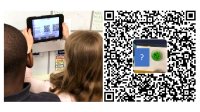Setting Up Easy Access to Digital Content in Elementary School
QR codes help children avoid technological mishaps and provide an easy way to incorporate student choice in the classroom.
Your content has been saved!
Go to My Saved Content.Teaching can be like driving on a highway: We want to make sure that everyone gets where they need to go safely without wasting valuable time. Just like on a highway, learners should have user-friendly entrance and exit ramps, highway signs of what’s to come, and lots of choice.
Getting all of your students to the desired links, videos, and pages can sometimes be tricky, but using QR codes is one possible route. They are a big help in the classroom, and can work in remote learning as well when schools or teachers are sending any paperwork home.
Easy to Learn and Easy to Use
QR (quick response) codes offer one way of linking to videos, blogs, polls, articles, discussion boards, and websites. As a classroom teacher, I often included QRs in my PowerPoint and Google Slides presentations, on premade cards placed in small groups, and on key rings to help students with specific learning goals (such as adding details to writing).
When my students saw QR codes, they knew to scan the code. There was no need for copying and pasting, no worries about students ending up on the wrong website, and no wasted time searching for the correct site.
How to Make a QR Code
Step 1: Decide where (site, link, or video) you would like to direct your students. Copy the link address.
Step 2: Download and then open a QR code generator (I like to use QR Code Generator) and paste the link from step 1 into the box that says “Enter your website.”
Step 3: Download the QR code and post it for your students.
How to Scan a QR Code
Step 1: On an iPad or iPhone, select and open the camera app. For Android phones, you’ll have to download a QR scanner app.
Step 2: Hover your phone over the QR code so that the image of the QR appears in the viewfinder.
Step 3: Click the link that appears at the top of your device.
There are many reasons to use QR codes, and I list some below.
QR Codes Offer Opportunities for Choice
I’ve often asked my students to select and watch two (or more) of the five QR code videos I provide on a given slide or handout. Students frequently comment that they watched more than what was required.
The use of this linking function creates fluid transitions from one activity to the next. Teachers can go from a whole group lesson to independent work to a Flipgrid discussion with QR code video links.
When my students conducted in-class social studies research, I frequently set up “bus stops” in the classroom and asked students to travel to two or three in a class period. At each stop, students were given five or six videos or links to explore. The use of the QR codes helped me expose my students to a variety of voices, information, and resources—while allowing for student choice.
QR Codes Offer Opportunities to Share Student Work
When I was a second-grade teacher, my students used QR codes to display their created stories and the work that they were proud of. We displayed the QR codes on the walls of our classroom, and during morning time or quiet time, students would scan a code and enjoy reading or watching the work of their peers.
Additionally, when students finished reading a book from our library, they had the option to handwrite their review or create a video and link to their review using a QR code. After the video was created, we simply printed the QR code and slipped it in the front of the book.
QR Codes Gamify Learning
Using QR codes as a clue or answer is also a fun way to loop kids into learning. During lessons, students can uncover QR code clues in Amazing Race–style challenges. This works especially well for memorization-heavy subjects and test prep.
For tests and review, students can also create flash QR cards with questions for tests or reviews. Each flash QR card could include a typed question and an answer accessible by QR code. I’ve found that students really enjoy this—some of my students were creating QR math estimation games during indoor recess and free time.
